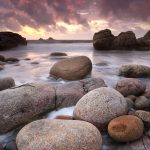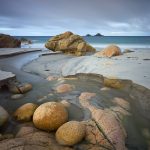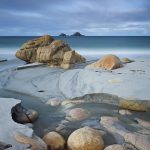Unless you are a local or a photographer you will probably never have heard of Porth Nanven. This tiny cove on the West Cornish coast seems to have hidden itself from the mass of holidaymakers that descend on Cornwall each summer. Perhaps the absence of a large sandy beach or lack of amenities deters most people. In any case, we should rejoice that the cove has remained so quiet and unspoiled, for this is surely one of the world’s most amazing coastal locations for landscape photography.
How To Get Here
From Penzance head west initially on the A30 before turning onto the A3071 towards St Just. After 6 miles you will reach St Just. Drive through the town and turn left into Cape Cornwall Road, and take the second left into West Place then Bosorne Road. Follow the sign for ‘Cot Valley’ which will lead you out of the town towards Porth Nanven reached in just 5 minutes. The road is narrow and steep with few passing places. Park at the end just above the cove.
Parking
- Parking Lat/Long: 50.118935, -5.699589
- Parking OS Grid Ref: SW 356 308
- Parking Postcode: TR19 7NT (nearby YHA hostel)
- Map: OS Explorer Map: 102 (1:25 000) Land’s End, Penzance and St Ives
What to Shoot and Viewpoints
Porth Nanven has all the ingredients to make a fantastic seascape. The granite here provides wonderful cliffs; crumbled into impressive stacks, or smoothed by waves into gorgeous curves. Offshore, a shapely double island named The Brisons provides a fine backdrop. But what really makes Porth Nanven special is the abundance of large granite boulders shaped by the sea over thousands of years into smooth rounded stones resembling giant dinosaur eggs.
- The Brisons islands from Nanven in the Cot Valley, Cornwall, England. Autumn (September) 2014. © Adam Burton
- Sunset over the Atlantic from the shores of Porth Nanven, Cornwall, England. Autumn (September) 2011. © Adam Burton
- Heart shaped pattern on a circular granite boulder, Porth Nanven, Cornwall, England. Spring (April) 2012. © Adam Burton
- Porth Nanven cove and The Brisons, Cornwall, England. Winter (December) 2012. © Adam Burton
Viewpoint 1 – The Cove
Most photographers visiting Porth Nanven will head straight down to the cove. As you reach the beach you have to carefully navigate the boulders to get closer to the water’s edge. This isn’t as difficult as it may at first look as the boulders are usually not slippery. On rare occasions the beach is covered in sand; although this makes access easier it usually means the beach is less photogenic. The classic viewpoint can be reached by crossing the stream and setting up just in front of the cliff face. At this position, there are usually fewer boulders leaving space to reveal the beautiful smooth curving ledges.
Viewpoint 2 – Ledges
For something a little different head to the raised ledges on the right hand side of the shore. There is a pathway through the rocks leading away from the cove. Along this path you will find a number of deep rock pools which at sunset can reflect colourful skies. This elevated position also makes a great place for shooting back across the cove in evening sunlight. The low sun setting out to sea can create spectacular rich side-lighting on the granite cliffs and also light up the crashing Atlantic waves.
Viewpoint 3 – Nanven
A 10 minute walk over the cliffs to the south of Porth Nanven brings you to an even less visited location. Named on the map as simply ‘Nanven’, this area has many of the same qualities that make its big brother so popular amongst photographers, yet feels very different. It also takes more effort to reach; at first you need to walk around a narrow coastal footpath before climbing down a little to reach the shore.
When you do reach the shore you will notice the difference immediately. Although there are still rounded boulders here, they are far fewer in number. Instead the whole area is a network of eroded lumpy granite ledges, channels and rock pools, with the occasional boulder here and there. With waves sweeping through the channels and over ledges, there is plenty of material to keep you occupied as you wait for a colourful sunset to develop over the Atlantic.
- Beautiful boulders on the sandy beach at Porth Nanven near Land’s End, Cornwall. Autumn (October) 2010. © Adam Burton
- Stormy evening at Porth Nanven in Cornwall, England. Winter (December) 2012. © Adam Burton
- Porth Nanven beach at twilight, St Just, Cornwall, England. Autumn (October) 2013. © Adam Burton
- Porth Nanven and The Brisons islands, St Just, Cornwall, England. Autumn (October) 2010. © Adam Burton
Accessibility
There is a small area with parking for several cars just above the cove. From there it is only a few minutes walk down into the cove. As mentioned above, access to the beach involves walking over large boulders so apply caution especially if algae are evident on the rocks. Not suitable for wheelchair users.
Best Time of Year/Day
With the sun descending over the Atlantic Porth Nanven makes an ideal sunset location any time. At high tide most of the cove is under water, so best to visit is when the tide is mid to low, and ideally falling. This ensures the rocks are still wet and sparkling. On windy days when the prevailing wind is blowing in off the Atlantic, sea spray can make it difficult to photograph at Porth Nanven. If possible, plan your visit on a day with low wind.









